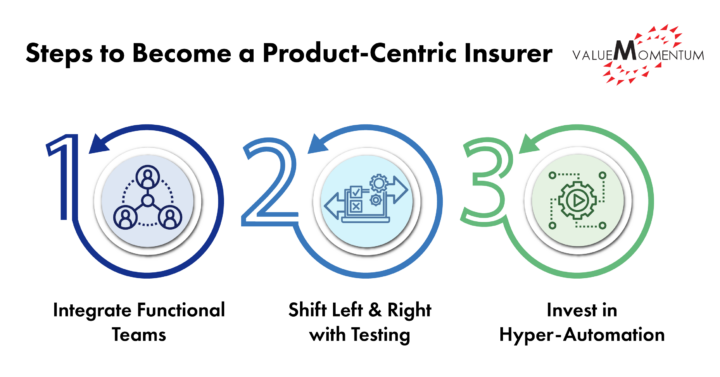The insurance industry faces a major shift—as low interest rates, Insurtech disruptions, and evolving customer demands place increasing pressure to incumbent carriers, current IT structures no longer suffice for the business goals that insurance leaders aim for today. Innovation, thus, is critical for a company’s growth model. In response to this need for innovation, leaders have been increasingly following the “product turn,” a management approach that centers the entire lifecycle of a product. The product-centric approach especially impacts quality engineering and application testing, amplifying operational and technical efficiencies for long-term evolution and business success.
To understand this turn toward products, insurers must first understand: what defines a product-focused approach? What existing challenges does this approach specifically tackle? And lastly, how can insurers take the steps to become product-centric themselves?
Product vs Project: The Distinction
Most insurers today remain attached to project-centric management, which involves pre-defined milestones and budget allocation, blackbox IT infrastructure, and a cost-center approach. Project-centric management usually sticks to a rigid (but exact) timeline with a linear set of objectives. Meanwhile, product-centric management focuses on creating ongoing iterations based on results, profits, and changing businessobjectives. This carries risks, but more growth opportunity; importantly, it emphasizes continuous deployment and integration for a fundamentally testing-driven and agile-oriented product cycle.
Challenges Toward Innovation
Product-centric management aims to tackle the following structural challenges that hinder innovation:
-
Legacy Mindsets
Project-centric management mirrors the limitations of legacy mindsets across scope, budget, and time. While knowing the exact terms for these three aspects can be helpful for initial product development, the lack of open-ended revision and change hinders achievements of long-term and continuous milestones. Importantly, it limits employees’ engagement to solely the given timeline and scope of a particular project and discourages collaboration across teams. Enterprises must transition to a mindset that elevates the reciprocal dependencies across varied product teams. The product-centric mindset will underscore the delivery of a particular set of business capabilities to a specific customer segment, bridging a more holistic product development.
-
Siloed Dev and Ops
Despite growing awareness of DevOps practices, functional silos continue to reinforce the Dev and Ops divide. This divide especially obstructs the continuous communication across teams such as design, code, and quality testing necessary to expand business capabilities. Functional silos foster a myopic view that focuses primarily on the success and input of a particular function than the larger product’s goal and mission. A product-centric DevOps follows a more consistent metric that moves the focus from a siloed, technical outcome to a central, unifying business outcome in collaborative teams. This change in viewpoint will allow teams to see a product’s full lifecycle in terms of profit and customer satisfaction.
-
Outdated Technology
Many organizations continue to rely on manual testing and waterfall methodologies that push quality testing to a latter phase of the product cycle. Project-centric management does not accommodate nor justify the need for advanced automation tools; the lack of such tools, however, greatly limits an insurer’s capacity to deploy software, identify defects, and enhance software consistently and efficiently. Product-centric management enables an integrated product life cycle that puts automation at its heart, keeping a product continuously tested and updated at every step. This decreases the risk of a product becoming outdated and also maintains services with continuous quality. It becomes not only recommended, but essential for insurers to invest in automation as part of a product-centric mentality.
Steps to Become a Product-Centric Insurer
Becoming a product-centric insurer requires a mass restructuring of IT teams, investments, and technologies that often go beyond the capacity of an insurer’s existing tools and management. However, three tasks emerge as guiding steps to start one’s journey:

-
Integrate Functional Teams
Multidisciplinary and cross-functional teams will be key to the success of product-centric management for insurers. These hybrid teams compose a constellation of functions that share responsibility and commitment over the final product quality, departing from the previous model of siloed teams with fixed roles and responsibilities. Testing will rely on a centralized competency center for continuous testing, as teams operate in incrementally adjusted steps under one stable value stream. This unified teamwork streamlines testing capabilities while allowing each team to keep focus of larger business goals at every step of the product cycle.
-
Shift Left and Right with Testing
Testing early and post-release in a product cycle—or to shift left and right, respectively—fundamentally underlie the continuous testing/deployment crucial to product-centric management and quality engineering. Shifting left maximizes error detection while opening space for continuous revision and feedback for quality. Ensuring an application’s success depends on the fusion of development and testing into a repeatable phase of the product cycle. Shifting right follows the same logic—embedding testing in both early and post-release steps allows for direct feedback loops across all stages to improve user experience and quality.
-
Invest in Hyper-Automation
Product-centric management requires insurers to rethink budgets from self-contained projects to continuous, ever-evolving products. A key necessity to this continuous evolution—testing, deployment, and integration—is hyper-automation. This means automating all aspects of the software lifecycle, from requirement analysis and test case development to regression testing and defect triaging. Product-centric management relies on this technology as its foundation for success. Insurers will benefit from partnering with a technology provider who can accommodate fully automated testing services for integrated teams, in addition to personalized capabilities across operations, security, and development.
Conclusion
The turn toward product-centric management is not unusual. Our expanding digital realm itself fosters rapid evolution of customer demands as well as new trends and practices to improve quality with real-time, data-driven feedback. Responding to these possibilities require a deep shift across people, technology, and process. Winners of this current landscape will be the ones who can fully utilize the latest automation tools, re-structure legacy systems and mindsets, and adopt a QE-driven product cycle that delivers customer-centric capabilities.
Ready to become a product-centric insurer? Check out our quality engineering services to start your journey now.
